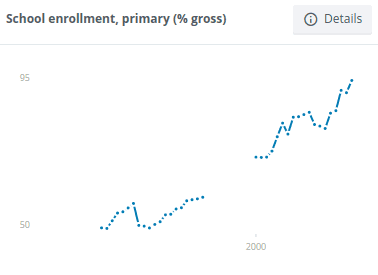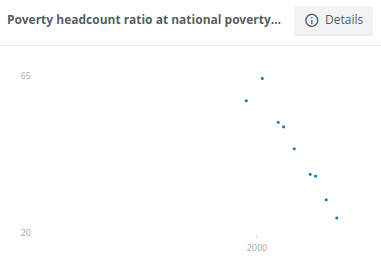Socio-economic conditions in Pakistan
July 05, 2020 - 3 min read
According to World Bank data from World Bank data for Pakistan (accessed 2020-07-04) as well as auxiliary data from the World Bank Pakistan country profile (accessed 2020-07-04), I extracted some figures which give a rough idea of socio-economic conditions in Pakistan. They are listed as follows:
-
GDP:
- Pakistan’s GDP for 2019 was USD 278.222B
- It peaked in 2018 at USD 314.568B
-
Population:
- 216.6M as of 2019
- 45M as of 1960
- Population growth rate of 2.1 % as of 2018
- Child mortality rate (for children under 5 years) of 6.9 % as of 2018
-
School enrollment (primary school):
- 94.3 % as of 2018
- 49.3 % as of 1971
- Primary education completion: 71 % as of 2018
- Secondary education enrollment: 43 % as of 2018
- Gender Disparity Index of 1 for primary school and secondary school enrollment combined: This indicates an equal enrollment of boys and girls
-
Percentage of people living below the poverty line:
-
As per national records:
- 24.3 % as of 2015
- 64.3 % as of 2001
- There has been consistent annual decrease in this ratio over the years
-
When adjusted for Purchasing Power Parity (2011) - I didn’t quite understand the 2011 bit there:
- 3.9 % as of 2018
- 8.3 % in 2010
- 28.6 % in 2000
- 58.9 % in 1990
-
-
Life expectancy:
- 67.1 years as of 2018
- 45.3 years as of 1960
- Consistent increase over the years
-
Gross National Income (GNI) per capita:
- USD 1530 as of 2019
- Peaked at USD 1590 in 2018
- USD 90 in 1960
- More or less consistent increase over the years
- USD 5110 when adjusted for Purchasing Power Parity as of 2018
- Military spending is 4 % of GDP as of 2018
- 72.6 % of the population have access to a cell phone and a subscription as of 2018
-
15.5 % of the population uses the internet as of 2018
- An internet user is one who has accessed internet in any form in the last 3 months
For more information on the digital landscape in Pakistan, checkout the post on Digital landscape in Pakistan
Thoughts
It seems that Pakistan is doing somewhat better than I thought. Some issues of concern that I see are:
-
Low secondary education enrollment rate
- This needs to be drastically improved
-
Possible reasons could be:
- Families don’t want their children to study
-
Children want to or are forced to earn an income instead of studying:
- Due to familial financial constraints
- Due to a lack of interest in education
- Prioritization of short-term gain over long-term
-
High child mortality rate
- Lack of access to medical facilities in remote areas
- National estimates of poverty are quite high at around a quarter of the population
- Cell phone usage is quite high and a large segment of the population can be served through that
- Internet usage is quite low and needs to expand quite drastically so that more people can have access to knoweldge, information, and digital services





